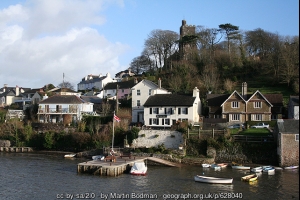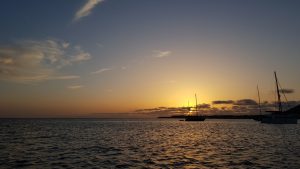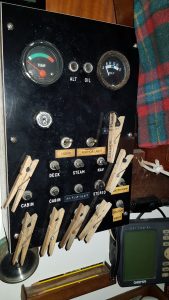
The marina and the anchorage at Las Palmas de Gran Canaria. Drone photo by Emmie and Tim of Shadowfax (www.chasing-contours.com)
Everybody’s waiting.
That’s what you do in the Canary Islands at this time of year. The boats have to get across the Bay of Biscay by the middle of September to avoid the equinoctial gales – but they mustn’t reach the Caribbean until the end of the hurricane season, and that means not setting off until the middle of November. So, for two months, they wait.
A lot of them are just parked in marinas – their crews flown back to the office. The rest exist in a peculiar sub-tropical limbo of cold beer under awnings.
The first week I was here, I stopped in a different place every night. That’s what you do when you’re cruising. Now I haven’t moved for two weeks. It took a while to realise the Canaries are not like Essex.
Well, of course not: The temperature is in the 30s. From twelve until four, nothing moves. I’ve given up soap – instead, I dive over the side before breakfast…
But, there’s more to it than that. Essex is full of rivers, so you can creep in around the mudbanks and find a sheltered spot whatever the weather.
The Canaries are extinct volcanoes (actually not so extinct – the one on La Palma is blowing off at the moment). Anyway, it means there are no estuaries. The only places to stop are open bays where the Atlantic swell rolls the onions off the chopping board or marinas where the man behind the counter shrugs sympathetically and tells you it’s high season. Not only does this mean high prices, but you might have to move on tomorrow because he’s got someone else booked in.
So there’s a great tendency for everyone to stay put – particularly the ARC boats.
The ARC is the Atlantic Rally for Cruisers – a massive event in which 200 boats with 1,200 crew sail across the Atlantic from Las Palmas to St Lucia all at the same time. It is one of the great mysteries of the sea that they don’t all bump into each other like a regatta of seven-year-old in Optimists. The event is massively social and hugely expensive, which means that most of the boats are seriously posh. This year, some of the catamarans have three decks, like wedding cakes.
It does seem rather a waste that they leave from Las Palmas, because – for some reason that nobody seems able to explain – the capital of these islands boasts the cheapest marina in Europe. They quoted me €55 for eight days. It’s like being in Southampton’s Port Solent – but the only time I stopped there for a night, it cost me £40. I could have stayed in a hotel.
Ah, but wait: In Las Palmas, this municipal generosity extends not just to the marina but also to the anchorage next to it. So that must make it the cheapest anchorage in the world!
Well, obviously, most anchorages are free. But it is one of the cruising yachtsman’s perennial moans that over the past 20 years, harbour authorities have sought to cash in on their local topography. For instance, halfway up the Truro River in Cornwall, where seafarers have sheltered for nothing ever since the first caveman stopped to fish from his coracle, the harbourmaster now turns up in his launch to relieve you of £7. There is no landing stage, no water tap. Nothing has changed in a thousand years – except for the introduction of “Harbour Dues”.
Yet here I am, securely anchored just off the popular Playa de las Alcaravaneras – high season and all that – and paying €1.42 a night. That doesn’t even cover the cost of the paperwork (there’s plenty of that). Also, they let me leave my dinghy in the marina and fill up the water can while I’m at it.
For a small additional charge, I could queue for the showers with all the ARC people. But if the sea is free and about the temperature of bathwater anyway…





As an even older man (78) I loved your book and blogs which I have just discovered. As a late covert to sailing after crewing for Frank Mulville in 1995 I have sailed a 22ft Catch22 across the channel for 20 years but have now been encouraged to venture further afield.
Great wordsmithing: “The rest exist in a peculiar sub-tropical limbo of cold beer under awnings.” I can see and hear it all.
I just discovered your blog and thank you very much. I am sixty two years old, I am a little French Auvergne who has exactly the same dream. I am preparing my departure for Mangata, my Cheoy Lee offshore 38 from 1979 based in La Rochelle. Sorry for my bad english.I use Google traduct . Is your Book tra’slated in french?
Bonjour Jean Claude, Non, j’ai bien peur que le livre ne soit disponible qu’en anglais. (J’espère que vous pouvez comprendre cela. Moi aussi, j’utilise Google Translate !) Cordialement, John
Hi John, just a suggestion, why don’t you post your stories on instagram with one of those lovely pictures you take? Thanks, take care, love your blogs even though I don’t usually comment, I read them all 🙂
I have an Instagram account “oldmansailing” for pictures.
Yes, I follow you on Instagram, but post your stories on there as well a pictures.
Thank you for the latest ( the cost of waiting) it’s dull and very still here in Alresford Hampshire. and the leaves are turning golden. Take care. Ursula j Weller
I’ve been watching the developments at La Palma for a month. Quakes have been building steadily over this time from daily average of 2.5 to current average 3.5 with a couple of >4.0 thrown in. The possibility of a big quake with ensuing landslide leading to tsunami from La Palma has been written about for decades as you might already know. I use an iPhone app called Earthquake to monitor the developments. It is unlikely the UK would be unaffected by such a tsunami, which could impact the whole Atlantic. Take care.
I can see Earthquake Alert and Earthquake Checker etc. But nothing just called Earthquake. Also, I seem to remember from the Christmas Day Tsunami that boats anchored in deep water hardly noticed anything. The trouble only started when the surge hit the beach.
I am 370metres from the low tide mark and anchored in 11metres (at low tide). Does this mean I can stop worrying – before I start…
Now, here is some useful information!
Just love your blogs,wish you would create a YouTube channrl
YouTube channel is oldmansailing – so is Instagram